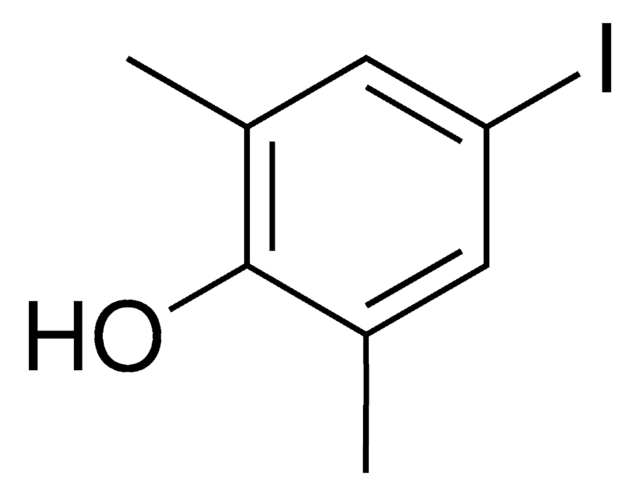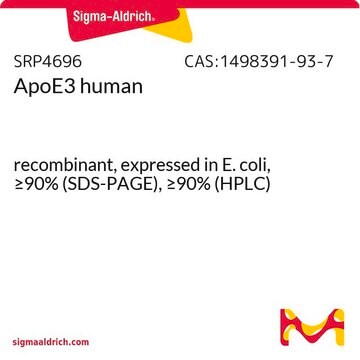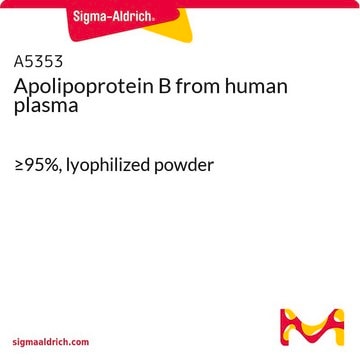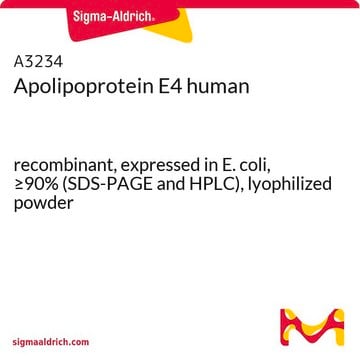Recommended Products
biological source
human
Quality Level
Assay
≤95% (SDS-PAGE)
form
liquid
manufacturer/tradename
Chemicon®
concentration
0.276 mg/mL
NCBI accession no.
UniProt accession no.
General description
Apolipoprotein E (Apo E) is a multifunctional protein and exists in 3 isoforms namely apoE2, apoE3, and apoE4. It is the constituent of plasma lipoproteins. Apo E is produced by various tissues and is majorly found in interstitial fluid and lymph. It is released in a lipid-poor form.
Application
Apolipoprotein E, human has been used as a standard for the quantification of ApoE protein in the sucrose density gradient (SDG) fractions and the unfractionated brain homogenates using an in-house developed sandwich enzyme-linked immunosorbent assay (ELISA). It has also been used in western blotting to assess its exogenous effects on low-density lipoprotein (LDL)-heparin interactions.
Biochem/physiol Actions
Apolipoprotein E (Apo E) serves as a ligand for low-density receptors and participates in the transport and redistribution of cholesterol and other lipids. It is thought to be involved in tissue repair as increased amounts of the protein are found at sites or peripheral nerve injury and regeneration. A mutant form is associated with type III hyperlipoproteinemia. Apo E plays a crucial role in neurobiology and neurodegenerative diseases.
Physical form
Liquid in 10 mM NH4HCO3, pH 8.0.
Legal Information
CHEMICON is a registered trademark of Merck KGaA, Darmstadt, Germany
Storage Class Code
12 - Non Combustible Liquids
WGK
WGK 2
Flash Point(F)
Not applicable
Flash Point(C)
Not applicable
Certificates of Analysis (COA)
Search for Certificates of Analysis (COA) by entering the products Lot/Batch Number. Lot and Batch Numbers can be found on a product’s label following the words ‘Lot’ or ‘Batch’.
Already Own This Product?
Find documentation for the products that you have recently purchased in the Document Library.
Yadong Huang et al.
Neurobiology of disease, 72 Pt A, 3-12 (2014-09-01)
Apolipoprotein (apo) E is a multifunctional protein with central roles in lipid metabolism, neurobiology, and neurodegenerative diseases. It has three major isoforms (apoE2, apoE3, and apoE4) with different effects on lipid and neuronal homeostasis. A major function of apoE is
Zaili Yang et al.
Journal of virology, 90(21), 9632-9643 (2016-08-19)
Hepatitis C virus (HCV) is a major cause of chronic liver disease, infecting approximately 170 million people worldwide. HCV assembly is tightly associated with the lipoprotein pathway. Exchangeable apolipoprotein E (apoE) is incorporated on infectious HCV virions and is important
Paul S Hauser et al.
Progress in lipid research, 50(1), 62-74 (2010-09-22)
Apolipoprotein (apo) E has a storied history as a lipid transport protein. The integral association between cholesterol homeostasis and lipoprotein clearance from circulation are intimately related to apoE's function as a ligand for cell-surface receptors of the low-density lipoprotein receptor
Erica Lana et al.
Frontiers in molecular neuroscience, 12, 176-176 (2019-08-17)
Background: A fundamental question in Alzheimer's disease (AD) is whether amyloid-β (Aβ) peptides and their deposition in the brain signify a direct pathological role or they are mere outcome of the disease pathophysiological events affecting neuronal function. It is therefore
Shobini Jayaraman et al.
Biochimica et biophysica acta. Molecular and cell biology of lipids, 1865(8), 158712-158712 (2020-04-15)
Low-density lipoprotein (LDL) binding to arterial proteoglycans initiates LDL retention and modification in the arterial wall, triggering atherosclerosis. The details of this binding, its effectors, and its ramifications are incompletely understood. We combined heparin affinity chromatography with biochemical, spectroscopic and
Our team of scientists has experience in all areas of research including Life Science, Material Science, Chemical Synthesis, Chromatography, Analytical and many others.
Contact Technical Service








